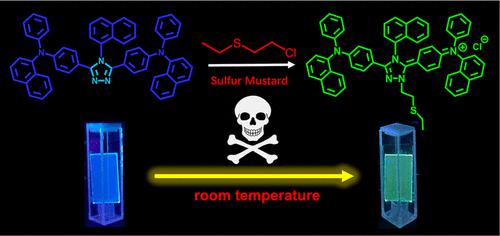Our official English website, www.x-mol.net, welcomes your feedback! (Note: you will need to create a separate account there.)
Ultrafast Sulfur Mustard Simulant Gas Fluorescent Chemosensors Based on Triazole AIEE Material with High Selectivity and Sensitivity at Room Temperature
ACS Sensors ( IF 8.9 ) Pub Date : 2022-07-12 , DOI: 10.1021/acssensors.2c00708 Ping Zheng 1 , Wenjuan Cao 1 , Yimeng Zhang 1 , Feng Li 1 , Ming Zhang 1
ACS Sensors ( IF 8.9 ) Pub Date : 2022-07-12 , DOI: 10.1021/acssensors.2c00708 Ping Zheng 1 , Wenjuan Cao 1 , Yimeng Zhang 1 , Feng Li 1 , Ming Zhang 1
Affiliation

|
Herein, a novel blue aggregation-induced enhanced emission (AIEE) material 4-N-(naphthalen-l-yl)-3,5-bis(4-N-phenyl-1-naphthylamine)phenyl-4H-1,2,4-triazole (NDTAZ) is developed and used as a fluorescent chemosensor for sulfur mustard (SM) simulant 2-chloroethyl ethyl sulfide (2-CEES) vapor. The NDTAZ chemosensor is designed by introducing an electron-donating N-phenyl-1-naphthylamine group at 3 and 5 position of 4H-1,2,4-triazole (TAZ) to enhance the nucleophilicity of the TAZ group, and a naphthalene ring is connected to 4 position of the TAZ group to construct an AIEE molecule. The NDTAZ films show extraordinary stability and then are further used as reliable and portable fluorescent chemosensors. Upon exposure to 2-CEES vapor, the NDTAZ chemosensor exhibits an instantaneous fluorescence response (not more than 1 s). What should be noted is that this fluorescent chemosensor realizes the visualized detection of fluorescent color change from blue to green at “room temperature”, which is rarely reported. The limit of detection is estimated to be 0.55 ppm, which is below the AEGL-1 (0.6 ppm for 1 min) safety ceiling level to SM exposure. Moreover, the NDTAZ chemosensor shows high selectivity toward 2-CEES vapor over closely related substances, including alkylating agents, aryl halide compounds, sulphur-containing compounds, and nerve agent mimics. More impressively, the NDTAZ chemosensor demonstrates good recyclability by water treatment. Also, the sensing mechanism is adequately proved by using multiple experimental methods and theoretical calculation. In addition, the NDTAZ-based facile filter paper-constructed test strips are fabricated for real-time and on-spot detection of leaked 2-CEES gas specifically. Therefore, this fluorescent chemosensor with excellent sensing performance greatly advances the practical detection of SM species at room temperature.
中文翻译:

基于三唑类AIEE材料的超快硫芥模拟气体荧光化学传感器在室温下具有高选择性和灵敏度
在此,一种新型蓝色聚集诱导增强发射 (AIEE) 材料 4- N -(naphthalen-l-yl)-3,5-bis(4- N -phenyl-1-naphthylamine)phenyl-4 H -1,2 ,4-三唑 ( NDTAZ ) 被开发并用作硫芥 (SM) 模拟物 2-氯乙基乙基硫 (2-CEES) 蒸气的荧光化学传感器。NDTAZ化学传感器是通过在 4 H -1,2,4-三唑 (TAZ) 的3 位和 5 位引入给电子N-苯基-1-萘胺基团来增强 TAZ 基团的亲核性和萘环连接到 TAZ 基团的 4 位以构建 AIEE 分子。NDTAZ _薄膜显示出非凡的稳定性,然后进一步用作可靠和便携式的荧光化学传感器。在暴露于 2-CEES 蒸气后,NDTAZ化学传感器会表现出瞬时荧光响应(不超过 1 秒)。需要注意的是,这种荧光化学传感器实现了“室温”下荧光颜色由蓝变绿的可视化检测,目前鲜有报道。检测限估计为 0.55 ppm,低于 SM 暴露的 AEGL-1(0.6 ppm,1 分钟)安全上限水平。此外,NDTAZ化学传感器对 2-CEES 蒸气的选择性高于密切相关的物质,包括烷化剂、芳基卤化物、含硫化合物和神经毒剂模拟物。更令人印象深刻的是,NDTAZ化学传感器通过水处理表现出良好的可回收性。此外,通过使用多种实验方法和理论计算充分证明了传感机制。此外,基于NDTAZ的简易滤纸构建的测试条专门用于实时和现场检测泄漏的 2-CEES 气体。因此,这种具有优异传感性能的荧光化学传感器极大地促进了室温下 SM 物种的实际检测。
更新日期:2022-07-12
中文翻译:

基于三唑类AIEE材料的超快硫芥模拟气体荧光化学传感器在室温下具有高选择性和灵敏度
在此,一种新型蓝色聚集诱导增强发射 (AIEE) 材料 4- N -(naphthalen-l-yl)-3,5-bis(4- N -phenyl-1-naphthylamine)phenyl-4 H -1,2 ,4-三唑 ( NDTAZ ) 被开发并用作硫芥 (SM) 模拟物 2-氯乙基乙基硫 (2-CEES) 蒸气的荧光化学传感器。NDTAZ化学传感器是通过在 4 H -1,2,4-三唑 (TAZ) 的3 位和 5 位引入给电子N-苯基-1-萘胺基团来增强 TAZ 基团的亲核性和萘环连接到 TAZ 基团的 4 位以构建 AIEE 分子。NDTAZ _薄膜显示出非凡的稳定性,然后进一步用作可靠和便携式的荧光化学传感器。在暴露于 2-CEES 蒸气后,NDTAZ化学传感器会表现出瞬时荧光响应(不超过 1 秒)。需要注意的是,这种荧光化学传感器实现了“室温”下荧光颜色由蓝变绿的可视化检测,目前鲜有报道。检测限估计为 0.55 ppm,低于 SM 暴露的 AEGL-1(0.6 ppm,1 分钟)安全上限水平。此外,NDTAZ化学传感器对 2-CEES 蒸气的选择性高于密切相关的物质,包括烷化剂、芳基卤化物、含硫化合物和神经毒剂模拟物。更令人印象深刻的是,NDTAZ化学传感器通过水处理表现出良好的可回收性。此外,通过使用多种实验方法和理论计算充分证明了传感机制。此外,基于NDTAZ的简易滤纸构建的测试条专门用于实时和现场检测泄漏的 2-CEES 气体。因此,这种具有优异传感性能的荧光化学传感器极大地促进了室温下 SM 物种的实际检测。


























 京公网安备 11010802027423号
京公网安备 11010802027423号